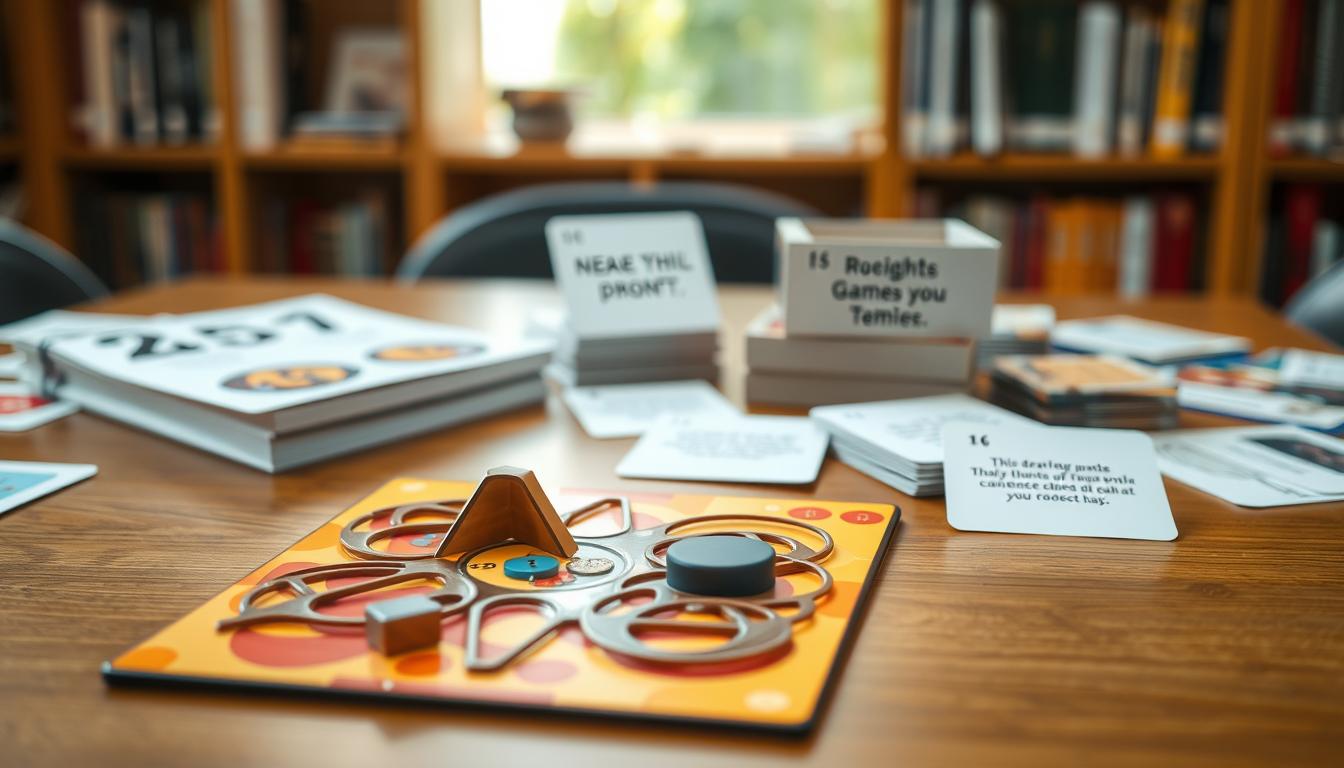Games that use metaphors and analogies to train symbolic thinking
Ever thought playing simple games could boost your symbolic thinking? The realm of brain games with metaphor-based logic is more than fun. It’s a key to unlocking your mind’s potential. These games use relatable metaphors and analogies to make complex ideas accessible. This way, they help develop crucial symbolic thinking skills.
By turning learning into a fun, interactive experience, these games unlock a player’s mental abilities. They make complex ideas easy to grasp, enhancing cognitive development.
Understanding Metaphors and Analogies in Game Design
Figurative language is key in making learning better and more fun. In game design, metaphors and analogies make games more engaging. They help players understand and connect with the game on a deeper level.
The Role of Figurative Language in Learning
Metaphors and analogies are great for learning. They help players see complex ideas in a simple way. This makes learning easier and helps players remember what they learn.
How Metaphors Enhance Cognitive Engagement
Metaphors in games make players think harder and be more creative. They connect game scenarios to real life, making players think more deeply. This improves problem-solving skills and lets players understand abstract ideas in a real way.

| Aspect | Traditional Learning | Game-Based Learning with Metaphors |
|---|---|---|
| Engagement Levels | Moderate | High |
| Retention of Information | Variable | Improved |
| Critical Thinking | Limited Opportunities | Enhanced Opportunities |
Importance of Symbolic Thinking in Education
Symbolic thinking is key in education. It lets students grasp complex ideas through symbols like words and images. This skill is vital for understanding tough subjects and helps students get a deeper understanding in many areas.
Defining Symbolic Thinking
Symbolic thinking starts early in life. Kids use symbols in play and learning words. It’s important to know symbols can mean many things, helping students link ideas together.
Applications in Various Fields
Symbolic thinking isn’t just for language. It helps in math by solving problems and using formulas. In science, it’s used to show theories with models and diagrams. Social studies use it to understand history and culture.
This skill is crucial in education. It boosts critical thinking, creativity, and communication skills.

Games that Use Metaphors to Enhance Learning
Metaphorical games are key in education. They boost critical thinking and cognitive skills through fun content. These games turn complex ideas into something easy to understand.
Games like Metaphoria show how metaphors can make learning more engaging. They help players understand and imagine better.
Examples of Effective Metaphorical Games
Many metaphorical games have shown their power in learning. For example, Metaphoria puts players in different situations. They must figure out metaphors to solve problems.
This approach makes complex ideas stick and sparks critical thinking. Games like Journey and Human Resource Machine also use metaphors. They teach through puzzles and emotional stories.
Impact on Critical Thinking Skills
Playing metaphorical games helps improve critical thinking. Players learn to analyze and solve problems using metaphors. This way, they see things from different perspectives.
This skill is crucial for school and life. It helps players make better decisions. By playing these games, learners get insights that improve their decision-making.
How Brain Games Using Metaphor-Based Logic Work
Brain games use metaphor-based logic to help us learn and grow. They use symbols to make complex ideas easier to understand. Players work with elements that stand for abstract concepts, helping them remember and use what they learn.
Game Mechanics and Symbolic Representation
Brain games are built on clever mechanics that make us think symbolically. Players face puzzles that require them to figure out metaphors to solve them. For example, a game might ask players to link different parts that represent big ideas, making learning fun.
This approach helps players improve their thinking skills as they tackle each challenge.
Engagement through Interaction and Feedback
Games keep players interested and motivated through interaction. Feedback helps players see how their choices affect the game, making learning more effective. This feedback loop encourages players to keep trying and learning.
By making decisions based on what they’ve learned, players get better at using this knowledge in real life.
| Game Element | Symbolic Representation | Player Interaction | Feedback Mechanism |
|---|---|---|---|
| Puzzles | Represent abstract ideas | Solving challenges | Instant results after attempts |
| Characters | Personify traits or skills | Making decisions that influence outcomes | Progress indicators and achievements |
| Scenarios | Analogous to real-life situations | Choosing paths or strategies | Warnings and hints for better choices |
The Science Behind Play and Learning
Research shows that play is key to learning. It helps kids learn better and grow their minds. Studies in schools prove that play makes learning fun and effective.
Play helps kids think creatively and solve problems. It’s a hands-on way to learn. This approach is great for young minds.
Play also helps kids grow socially and emotionally. It teaches them to work together and communicate. This makes them better at teamwork and talking to others.
Playful learning makes learning deeper and more meaningful. It uses metaphors to help kids understand better. This way, they get to learn in a fun and engaging way.
In short, play and learning go hand in hand. Science backs up the benefits of play in education. It makes learning fun and helps kids love learning for life.
Case Studies of Successful Metaphor Games
Looking into metaphor games shows how they work in schools and therapy. The Metaphoria case study shows a 3D game’s power in medical education. It also shows how metaphor games help kids grow emotionally and develop.
Metaphoria: Enhancing Medical Education
The Metaphoria case study is a big win for using metaphor games in medical school. This 3D game teaches history-taking skills to future doctors. Students play in a world that feels like real doctor visits.
Studies show more students are interested and learn better. This proves that playing metaphor games helps keep information in their minds and improves skills.
Creative Learning through Play Therapy
Play therapy uses metaphor games to help kids express feelings and understand emotions. Kids play games that match their life, helping them see things clearly. This helps them talk about their feelings and grow.
This mix of play and metaphor shows the wide use of these games in learning and therapy.
Diverse Formats of Metaphor-Based Games
Metaphor-based games come in many forms, like board games and video games. Each offers a unique way to engage players and boost their thinking skills. These games show how metaphors can help teach and improve our minds through fun.
Board Games and Their Symbolic Structures
Board games use symbols to create fun experiences. Games like “Dixit” and “Codenames” use pictures and metaphors to make players think deeply. They help players talk and understand each other better, while also sharpening their minds.
Video Games with Rich Metaphorical Narratives
Video games tell stories filled with metaphors. Games like “Journey” and “Celeste” share themes of adventure, strength, and growth. Players connect with these stories, making the learning experience more meaningful.
| Game Format | Examples | Strengths | Weaknesses |
|---|---|---|---|
| Board Games | Dixit, Codenames | Enhances social interaction, simple mechanics | Limited scalability for larger groups |
| Video Games | Journey, Celeste | Deep narratives, immersive experiences | Requires access to technology, potential for screen fatigue |
Teaching Symbolic Thinking through Game Play
Using games in education boosts students’ grasp of symbolic thinking. Teachers can use metaphor-based games to make learning fun and memorable. This approach not only sharpens thinking skills but also fosters teamwork among students.
Strategies for Educators
Teachers can make metaphor-based games a part of the curriculum in several ways:
- Offer a variety of games with different stories to help students see symbolic thinking from many angles.
- Have group talks after games to discuss the metaphors and how they apply in real life.
- Set up play sessions where students can plan and share their views on symbolic meanings.
- Add art and creative projects that tie into the game’s metaphors to deepen understanding.
Measuring Learning Outcomes
It’s important to check how well students learn from games. Teachers can use both qualitative and quantitative methods to see if games work:
- Use tests before and after games to see if students understand symbolic thinking better.
- Have interviews or focus groups to hear what students think about their game experiences.
- Look at how engaged students are during games to see how much they participate and interact.
- Use checklists to observe how well students apply symbolic thinking in discussions and activities.
Integrating Metaphors into Game Design Principles
Creating engaging games with metaphors needs a grasp of key game design principles. Visual metaphors in games are key tools that boost player interest and make gameplay better. They help developers connect with players on a deeper level, making the game more meaningful and fun.
Visual Metaphors and Gameplay Dynamics
Visual metaphors play a big role in game dynamics by turning complex ideas into real experiences. They help players understand hard concepts through images they know. For example, a broken bridge can show a broken relationship, stirring emotions and encouraging thought.
This method fits well with game design principles that focus on being clear and relatable. By using strong visual metaphors, developers can build worlds that players can really connect with.
Engaging Diverse Learning Styles
Good game design must think about different learning styles to reach all players. Some people learn best with pictures, others with hands-on activities, and some with sounds. By adding various visual metaphors and interactive parts to games, developers can make a space that welcomes everyone.
This flexibility helps players learn better, as they can understand the metaphors in a way that feels right for them.
The Role of Creativity in Metaphorical Games
Creativity is key in making metaphorical games. These games use imaginative play to draw players in. They let players explore abstract ideas through fun, interactive ways.
Game designers use creative methods to tell stories. These stories help players grasp complex metaphors in a way that feels real. This makes the games more engaging and meaningful.
Imaginative play lets players dive into metaphorical thinking. It opens up new ways of seeing things. Players go on adventures that challenge them to think creatively.
This creative journey not only makes the game more fun. It also helps players grow intellectually. It teaches them to think outside the box and solve problems in new ways.
Evaluating the Effectiveness of Games on Symbolic Thinking
Looking into how games help with symbolic thinking is complex. It involves both numbers and what people say. By using different ways to measure, teachers and researchers can understand how games help our brains grow.
Quantitative Research Outcomes
Quantitative analysis uses numbers to see if games work. Tests and surveys show if students get better at thinking symbolically. For instance, tests before and after playing games show big improvements in understanding symbols and analogies. Some key numbers include:
| Measurement Type | Outcome Indicators | Sample Size |
|---|---|---|
| Standardized Tests | Score Improvement | 200 |
| Behavioral Observations | Engagement Levels | 150 |
| Surveys | Confidence in Skills | 250 |
Qualitative Assessments and Feedback
Qualitative feedback gives deep insights into what students think about metaphor-based games. Through interviews and surveys, we learn about their growth and fun. Teachers use this to make games better and teach more effectively. Some common themes are:
- More interest in learning.
- Better critical thinking.
- More fun playing.
Future Trends in Metaphorical Game Development
The world of metaphorical game development is changing fast. More focus is on serious games that teach us something. Educators and game makers are teaming up to make games that are fun and educational.
The Growing Interest in Serious Games
Serious games are becoming more popular. They make learning fun and effective. These games use metaphors that players can relate to, making them more engaging.
As more people see the value of serious games, they’re being used in schools. This means students will get to experience learning in a new, exciting way.
Emerging Technologies and Their Potential
New tech like virtual reality (VR) and artificial intelligence (AI) are changing the game. VR lets players dive into virtual worlds, making learning interactive. AI gives feedback that’s just right for each player, helping them learn at their own pace.
Challenges in Implementing Metaphorical Games in Education
Adding metaphorical games to schools comes with big hurdles. Teachers need to know these challenges to make learning better. Issues like school rules, money problems, and wrong ideas about games can stop them from being used.
Barriers to Adoption in Traditional Classrooms
Old-school classrooms often struggle to use metaphorical games. Some big problems are:
- Administrative Resistance: School bosses might not want to try new tech, worried it will mess up their plans.
- Budget Constraints: Schools often don’t have enough money for new tech, like metaphorical games.
- Lack of Training: Teachers might not know how to use these games well in their lessons.
Addressing Common Misconceptions
There are wrong ideas about learning games that make things harder. We need to fix these to change how people see games. Some common wrong beliefs are:
- Games Are Just for Fun: Many think games are not serious learning tools, which is not true.
- Limited Outcomes: Some believe games don’t help students learn well, even though they do.
- Incompatibility with Learning Standards: Some teachers think games can’t fit with what students need to learn, which is not right.
Conclusion
Metaphorical games are powerful tools for improving symbolic thinking. They use metaphors and analogies to engage learners in new ways. This helps players develop critical thinking and creativity.
Symbolic thinking is key in education. It helps students understand and work with abstract ideas. Metaphorical games show how they can boost critical thinking and make learning fun.
As we learn more about these games, we see their value in education. They offer a chance to make learning more interactive and engaging. By embracing symbolic thinking, we can help the next generation think more creatively and critically.
FAQ
What are metaphor-based games and how do they enhance learning?
Metaphor-based games use figurative language to help students understand better. They make learning fun and engaging. Players think critically and remember information better.
Why is symbolic thinking crucial in education?
Symbolic thinking helps students use symbols to represent ideas. It’s important in subjects like language, math, science, and social studies. It boosts learning and critical thinking skills.
Can you provide examples of metaphor-based games?
Metaphoria is a game that improves critical thinking and cognitive skills. It makes learning fun and interactive. Players get to understand content in a new way.
How do brain games utilizing metaphor-based logic function?
These games teach through symbols and engaging gameplay. Players learn by interacting with the game. It helps them apply what they learn in real life.
What research supports the effectiveness of games in learning?
Studies show games help with learning and cognitive development. They support the idea that play is key in education. Games improve mental growth and problem-solving skills.
How do metaphor-based games support various learning styles?
These games use visual metaphors and stories to engage different learners. They offer dynamic experiences. This helps developers create games that work for everyone.
What challenges do educators face in integrating metaphorical games?
Educators face issues like resistance, budget problems, and doubts about game-based learning. Overcoming these challenges is key to using games in classrooms.
How can educators assess the effectiveness of metaphor-based games?
Teachers can use feedback and tests to measure learning. This helps improve teaching methods. It shows how games impact learning.
What future trends do you see in metaphor-based game development?
The future looks bright for metaphor-based games. There’s growing interest in educational games. New tech like VR and AI will make games more engaging and effective.














